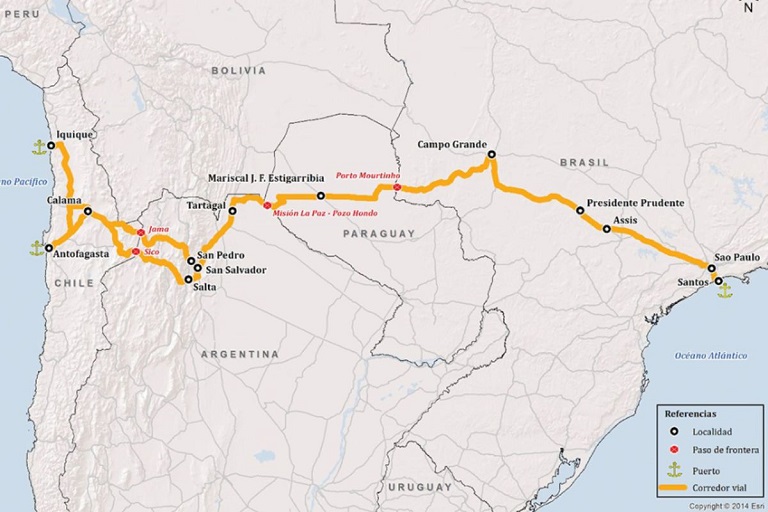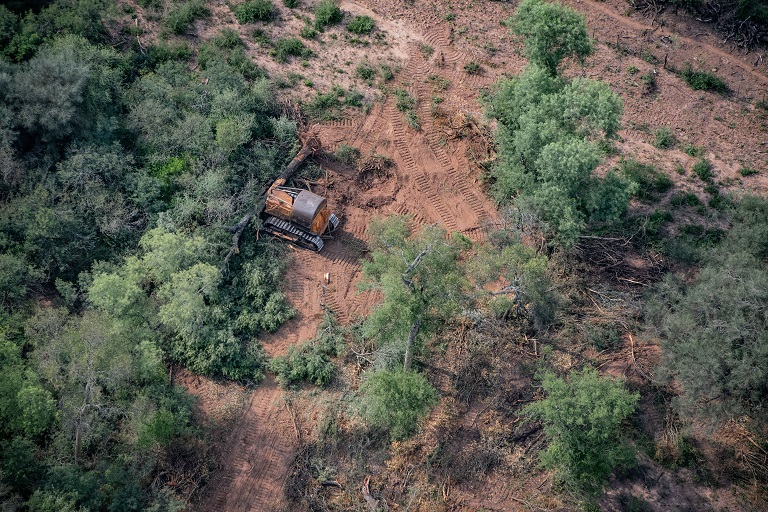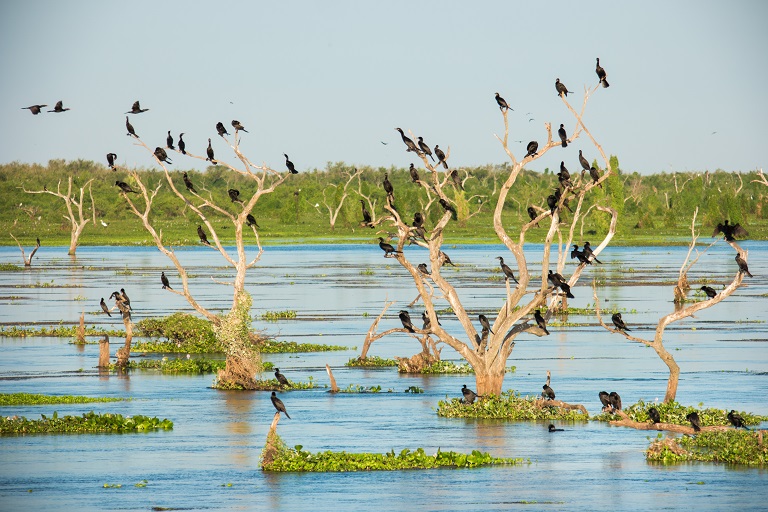- Dubbed the new Panama Canal, the 2,290-kilometer (1,423-mile) Bioceanic Corridor will connect Chile to Brazil via Argentina and Paraguay and aim to reduce freight transport costs.
- The highway crosses the Gran Chaco, one of the world’s most threatened biomes, which has already lost a fifth of its forest since 1985 due to agricultural expansion.
- Conservationists warn that the highway will lead to a surge in deforestation and an increase in the number of vehicle collisions, putting both people and wildlife at risk.
- Mitigating the environmental and social risks associated with the highway requires stronger political will and more robust implementation of protective regulations, experts say.
The Gran Chaco, South America’s second-largest forest after the Amazon, has been steadily replaced by croplands and cattle ranches for decades. Now, the semiarid lowland faces a new threat: the Bioceanic Corridor mega-highway that cuts through the Chaco to connect Chile and Brazil via Argentina and Paraguay. While advocates claim the road will boost the economy and strengthen trade links, conservationists warn it puts under threat local wildlife populations and people.
The 2,290-kilometer (1,423-mile) road begins on Chile’s Pacific Ocean coast before winding east across the Gran Chaco in Argentina and Paraguay and finishing in the state of Mato Grosso do Sul, Brazil’s agricultural powerhouse. First approved in 2015, the project’s completion is estimated for 2025, with Paraguay already advancing quickly on its part. “This is going to be the great Panama Canal,” Mario Abdo Benítez, the Paraguayan president, said in a 2022 speech.

The road aims to reduce cargo travel time and costs to lucrative Asian and Oceania markets as well as increase tourism in the region. In Brazil, it offers an alternative to the existing road from Mato Grosso do Sul to the port of Santos in São Paulo, cutting transport time by up to 17 days. For Paraguay, the third-largest soy exporter in the world, the road represents not only an opportunity to boost the economy but to improve the country’s social accessibility and connectivity.
While savings will be made in the commodity sector, experts say the environment and its local communities may end up paying a high price. “Linear infrastructure, such as roads in mostly wild spaces, bring with it a potential negative impact due to the greater accessibility to those territories. This is undoubted,” Alejandro Brown, the president of Fundación ProYungas, an Argentina-based NGO focused on sustainable development and conservation, told Mongabay by phone.
“This is a security issue”
One of the biomes conservationists are most concerned about is the Gran Chaco, a mosaic of savannas and wetlands that sprawls 1.1 million square kilometers (424,712 square miles) across Argentina, Paraguay, Bolivia and Brazil. It’s one of the planet’s most biodiverse regions, home to 3,400 plant species, almost 500 bird species, 150 mammal species, 297 reptilian and 186 amphibian species.
It is also disappearing faster than any other forest in the world. Since 1985, a fifth of Chaco’s forest has been cut down, and the rate of deforestation has accelerated in recent years. From 2010-12, an average of one acre of native Chaco vegetation per minute was lost in Argentina, Paraguay and Bolivia. In Paraguay, where nearly two-thirds of the country’s surface area is covered in Chaco, the biome is highly threatened by agricultural development, mostly beef and soy.

Some conservationists see the new highway as an opportunity to ramp up protection efforts in the vulnerable Chaco region and create more robust regulations. “The Bioceanic Corridor is a potential threat — but everything will depend on how we face it,” Brown said. “It will generate more visibility for a territory that is quite invisible, and I believe that we have the opportunity to use that visibility as a greater commitment to protect the environment. Economic interest can also generate biodiversity conservation in a proper planning framework.”
Others are concerned the construction of the highway could trigger further commercial activity in the region, causing more damage to the environment and the communities that reside there. According to biologist Matías Mastrángelo, the construction of any road that reduces the costs of transportation from farms to ports, including the Bioceanic Corridor, will increase agricultural expansion and deforestation. “We have seen that farmers in the agricultural frontiers of the Chaco, Cerrado, Amazon, etc, reinvest their surplus profits in expanding cultivated areas through mechanical forest clearing and fire,” Mastrángelo told Mongabay by email.
Any agricultural expansion will “amplify the impacts that the region has been already experiencing for the last three decades,” he added, including the loss of biodiversity and the subsequent ecosystem services such as pollination, pest regulation and prevention of extreme events such as floods and droughts. “All of these will have a stronger negative impact on the most vulnerable social groups, such as small-scale peasant farmers and Indigenous people,” he said.
The Ayoreo communities and isolated subgroups such as Ayoreo-Totobiegosode in the Chaco region, for example, have already lost huge swaths of their land to cattle ranches, many of which were taken by national and foreign ranching companies, according to Survival International, an NGO that champions Indigenous rights. The new highway could worsen these issues. “The greatest current threat to the Ayoreo-Totobiegosode is deforestation,” according to a Survival International statement.
Experts say that to mitigate such risks, foreign importers need to be stricter about refusing to purchase goods from deforested areas. Also, South American governments must implement more effectively existing environmental protections and land-use planning laws. “Such effective implementation requires more political will and institutional capacity to sanction unsustainable practices and reward sustainable ones, such as ecotourism and sustainable forestry,” Mastrángelo said.
Another concern is an increase in collisions that will affect people and wildlife along the entire highway, especially from the higher volume of freight transport. “With the increase of trucks, it increases the number of animals killed,” Arnaud Desbiez, the president of Brazil-based NGO Wild Animal Conservation Institute, told Mongabay by phone. “But this is not just about wildlife conservation, this is a security issue. People die on our roads. More people will die due to this.”
Studies conducted in Mato Grosso do Sul, where the Bioceanic Corridor will pass through, estimated that more than 40 giant anteaters die for every 100 km of paved road. “Little by little, [roads] can cause extinctions when roadkill is added to other problems such as habitat loss, fires and conflict with domestic dogs,” Desbiez said.

Paraguay has promised to add 14 wildlife crossings to the road — but experts say it’s not enough. “Our data with giant anteaters show that only 1% of the animal crossings are done using wildlife underpasses, and that’s because [giant anteaters] use them very opportunistically,” Desbiez said.
Combining fences to guide animals toward the underpasses and data that pinpoint the areas of the highest probability of collisions is the most effective way to implement mitigation measures. “What we’re hoping for now is more political will and funding because it’s expensive. But we need wildlife vehicle collisions to be part of any infrastructure initiative,” Desbiez said. “What we’re advocating is roads that are safe for all, for people and for wildlife.”
Banner image: Experts warn that without the necessary mitigation steps, the new highway will increase the number of vehicle collisions, impacting the lives of both people and wildlife. Image © Alejandro Espeche/Greenpeace.
Citation:
Ascensão, F., & Desbiez, A. L. (2022). Assessing the impact of roadkill on the persistence of wildlife populations: A case study on the giant anteater. Perspectives in Ecology and Conservation, 20(3), 272-278. doi:10.1016/j.pecon.2022.05.001
FEEDBACK: Use this form to send a message to the author of this post. If you want to post a public comment, you can do that at the bottom of the page.
